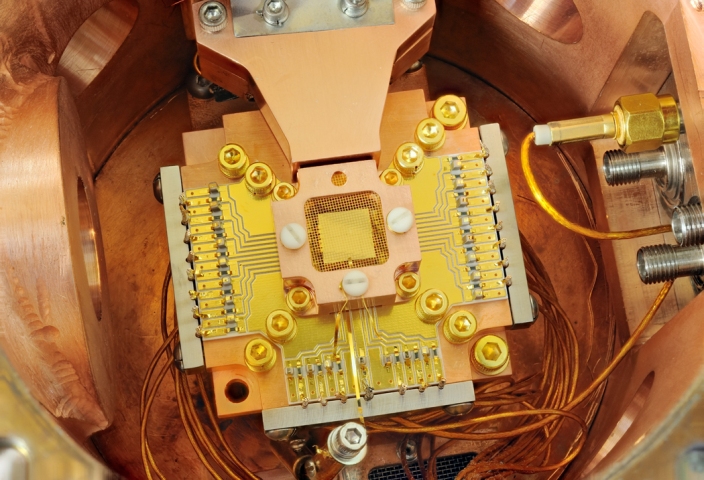Feb 23 2011
Physicists at the National Institute of Standards and Technology (NIST) have for the first time coaxed two atoms in separate locations to take turns jiggling back and forth while swapping the smallest measurable units of energy.
By directly linking the motions of two physically separated atoms, the technique has the potential to simplify information processing in future quantum computers and simulations.
Described in a paper published Feb. 23 by Nature,* the NIST experiments enticed two beryllium ions (electrically charged atoms) to take turns vibrating in an electromagnetic trap, exchanging units of energy, or quanta, that are a hallmark of quantum mechanics. As little as one quantum was traded back and forth in these exchanges, signifying that the ions are "coupled" or linked together. These ions also behave like objects in the larger, everyday world in that they are "harmonic oscillators" similar to pendulums and tuning forks, making repetitive, back-and-forth motions.
 NIST physicists used this apparatus to coax two beryllium ions (electrically charged atoms) into swapping the smallest measurable units of energy back and forth, a technique that may simplify information processing in a quantum computer. The ions are trapped about 40 micrometers apart above the square gold chip in the center. The chip is surrounded by a copper enclosure and gold wire mesh to prevent buildup of static charge. Credit: Y. Colombe/NIST
NIST physicists used this apparatus to coax two beryllium ions (electrically charged atoms) into swapping the smallest measurable units of energy back and forth, a technique that may simplify information processing in a quantum computer. The ions are trapped about 40 micrometers apart above the square gold chip in the center. The chip is surrounded by a copper enclosure and gold wire mesh to prevent buildup of static charge. Credit: Y. Colombe/NIST
"First one ion is jiggling a little and the other is not moving at all; then the jiggling motion switches to the other ion. The smallest amount of energy you could possibly see is moving between the ions," explains first author Kenton Brown, a NIST post-doctoral researcher. "We can also tune the coupling, which affects how fast they exchange energy and to what degree. We can turn the interaction on and off."
The experiments were made possible by a novel, one-layer ion trap cooled to minus 269 C (minus 452 F) with a liquid helium bath. The ions, 40 micrometers apart, float above the surface of the trap. In contrast to a conventional two-layer trap, the surface trap features smaller electrodes and can position ions closer together, enabling stronger coupling. Chilling to cryogenic temperatures suppresses unwanted heat that can distort ion behavior.
The energy swapping demonstrations begin by cooling both ions with a laser to slow their motion. Then one ion is cooled further to a motionless state with two opposing ultraviolet laser beams. Next the coupling interaction is turned on by tuning the voltages of the trap electrodes. In separate experiments reported in Nature, NIST researchers measured the ions swapping energy at levels of several quanta every 155 microseconds and at the single quantum level somewhat less frequently, every 218 microseconds. Theoretically, the ions could swap energy indefinitely until the process is disrupted by heating. NIST scientists observed two round-trip exchanges at the single quantum level.
To detect and measure the ions' activity, NIST scientists apply an oscillating pulse to the trap at different frequencies while illuminating both ions with an ultraviolet laser and analyzing the scattered light. Each ion has its own characteristic vibration frequency; when excited, the motion reduces the amount of laser light absorbed. Dimming of the scattered light tells scientists an ion is vibrating at a particular pulse frequency.
To turn on the coupling interaction, scientists use electrode voltages to tune the frequencies of the two ions, nudging them closer together. The coupling is strongest when the frequencies are closest. The motions become linked due to the electrostatic interactions of the positively charged ions, which tend to repel each other. Coupling associates each ion with both characteristic frequencies.
The new experiments are similar to the same NIST research group's 2009 demonstration of entanglement—a quantum phenomenon linking properties of separated particles—in a mechanical system of two separated pairs of vibrating ions (see http://www.nist.gov/pml/div688/jost_060309.cfm). However, the new experiments coupled the oscillators' motions more directly than before and, therefore, may simplify information processing. In this case the researchers observed quantum behavior but did not verify entanglement.
The new technique could be useful in a future quantum computer, which would use quantum systems such as ions to solve problems that are intractable today. For example, quantum computers could break today's most widely used data encryption codes. Direct coupling of ions in separate locations could simplify logic operations and help correct processing errors. The technique is also a feature of proposals for quantum simulations, which may help explain the mechanisms of complex quantum systems such as high-temperature superconductors.
In addition, the demonstration also suggests that similar interactions could be used to connect different types of quantum systems, such as a trapped ion and a particle of light (photon), to transfer information in a future quantum network. For example, a trapped ion could act as a "quantum transformer" between a superconducting quantum bit (qubit) and a qubit made of photons.
This NIST research was supported in part by the Intelligence Advanced Research Projects Activity, Defense Advanced Research Projects Agency and Office of Naval Research.
As a non-regulatory agency, NIST promotes U.S. innovation and industrial competitiveness by advancing measurement science, standards and technology in ways that enhance economic security and improve our quality of life.
*K.R. Brown, C. Ospelkaus, Y. Colombe, A.C. Wilson, D. Leibfried & D.J. Wineland. 2010. Coupled quantized mechanical oscillators. Nature. Published online Feb. 23.